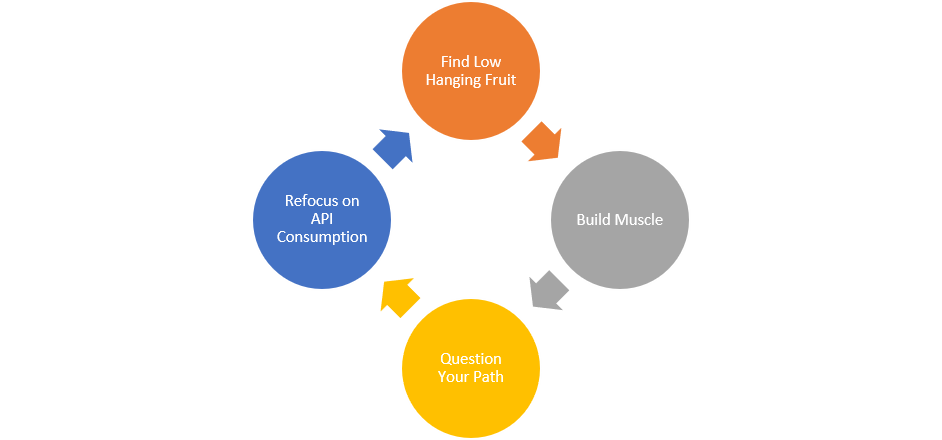Sometimes, it seems that we can never relax, that there is always something to chase, something left to build and any success to celebrate. API Design First is no exception. After speaking with a few customers and listening to Axway’s Catalyst team, follow along with my logic and let me know if you agree.

The API First Journey
- Find the low hanging fruit. When we first start our API First journey, we are looking for the right project and the right team. We want the Goldilocks project—just strategic enough that success matters and will be celebrated but not so critical that a stumble jeopardizes our careers. But we want a team with good technologists, folks who are interested in learning new skills—open, engaged team members who can deliver. You know this can be harder than you would think. The feeling that choosing wisely is equal to success can be paralyzing. One path through if resources allow is to choose two projects:
- Create APIs for enterprise resources such as master data management (MDM).
- Ask a strategic project team to adopt API First.

When you enable an enterprise resource, such as customer master in a scenario, such as an API, your investment has the benefit of potential wide adoption, multiplying the value and getting the word out.
And, when a strategic project adopts design-first thinking, the visibility and importance of APIs can become mission-critical, accelerating management acceptance and funding for new projects.
But sometimes putting a single API on an enterprise MDM asset is harder than it looks. We find that our API champions have more control over enterprise resources like MDM but the visibility of a strategic project especially one that has a business or partner engagement can be invaluable. Sometimes choosing two projects can increase the opportunity for success.
- Build muscle. Soon after starting on your API First journey, you will probably realize that you can’t do it all—you can’t get there fast enough; you don’t have enough trained resources, etc. I don’t have an easy solution to this situation, but perhaps it helps to know that everyone seems to hit this same wall.
- Option 1: If your financial culture is supportive, you can engage a large consultancy and augment staff with their team. This approach works best if the consultancy’s approach is well aligned with your own thinking.
- Another option is coaching and mentoring. This approach uses far fewer outside staff and ensures that each team has one or more senior advisors/mentors assigned. The coach and mentor approach can be time-boxed to an epic cycle that can last around 90 days. This scenario provides good value for the money and ensures your team owns its own future.

- Question Your Path. If you are asking yourself, “Wait, is this right? Am I missing something?” then you have arrived at Stage 3. Maybe you are a stalwart, completely convinced that APIs are key to saving your company and your platform from obsolescence. Yet, your management team isn’t convinced and you have to sell yourself and/or your team all over again. Frustrating, isn’t it? Why can’t human beings just love change and embrace it in every stage? Well, we don’t, and I guess that we can’t.

So take inventory–what has worked, what hasn’t? Benchmark yourself against others you admire (Caution: Be sure that the benchmark is real. There are a lot of manufactured success stories out there). Most importantly, listen to your team. Are the mainframe developers not getting it? Is your high-paid data scientist not seeing the value of his work?
Critically, ensure your organization agrees on the answer to this question: What is an API and why is it valuable to your organization? You may find that the current approach needs tweaking or a fresh start. Don’t be afraid to start over if your prior approach isn’t working in your culture and with your projects. Remember, education and learning never ends.
Now more than ever and before you embark on the next stage of the cycle, you need insight into API metrics. One of the most important things you can do to ensure success is to curate APIs:
- Do you have an API Portal? Are your APIs discoverable?
- Is there a good, balanced variety of time-to-success documentation?
- How easily can developers test APIs?
- Does your gateway have analytics and security to monitor, measure and protect your APIs from well-intentioned misuse?
Security is so critical that we will save the entire topic for another day.
- Focus on API Consumption. Look at what the API provides the consumer from the “outside-in” before viewing from an API provider standpoint. The stages to date have been about getting started, gaining skill and tackling projects. Now you want your colleagues—“the business”—and your ecosystem partners to use your APIs. External use is often when you know you are on the right path you are at the right speed and well on your way. Why is it so important to look at consumption and especially external consumption? One trap of Stage 1, looking for low hanging fruit, is the tendency to do simple projects such as API-enable integration to your IT ticketing application. Literally, hundreds of APIs can be created and deployed just to monitor applications in large shops. This view is important work but probably not transformative enough to convince senior leaders that API-First is mission-critical. Be sure to look at the bigger picture. Remember this stage is often when multiple puzzle pieces snap together—Agile sprints with users who can now begin to use APIs or need APIs to meet timelines.

Ideas
Here are some ideas to help you find the right project and team. The Chief Experience Officer needs API methodology to deliver differentiated, game-changing user interfaces and API-First is just what that team needs to deliver their goals.
For other partners and colleagues who are accelerating product design or moving to a real-time organization, design-first thinking is the missing ingredient to real adoption in the ecosystem and better data for decision-making.
Don’t be afraid
Don’t be afraid to build alliances with new teams both inside and outside your organization. When you are building new solutions with APIs not just creating APIs, you know that Stage 4 is achieved.
But guess what? The cycle continues. Not surprised? Be sure to take a deep breath and celebrate with your teams, your colleagues, and partners. Publish the results, lay out the metrics. Don’t assume that everyone gets it. Oh, and by the way, start looking for low hanging fruit.
Ready to take the next step in your API First Journey? Meet Axway’s Catalysts.


